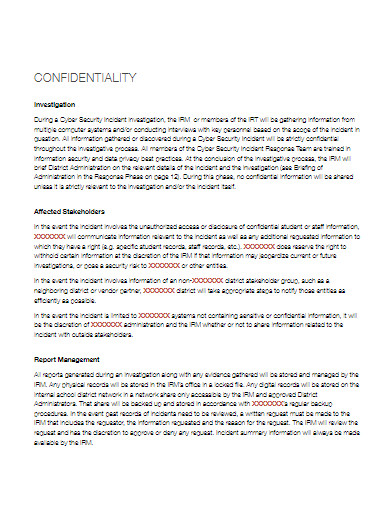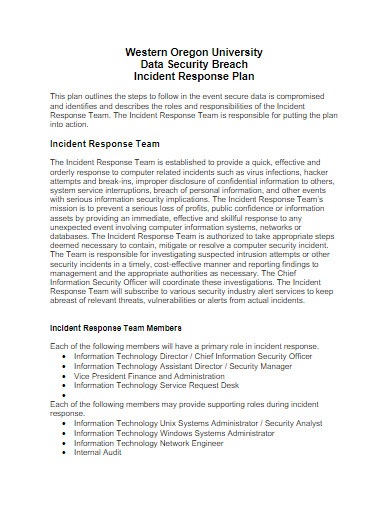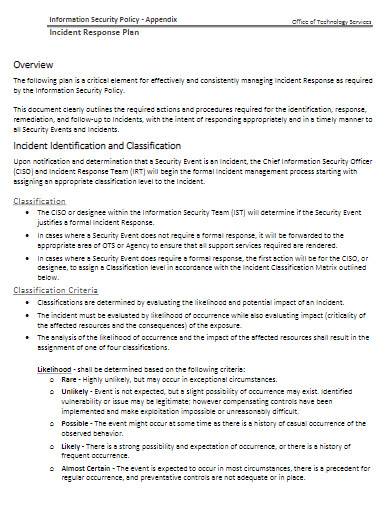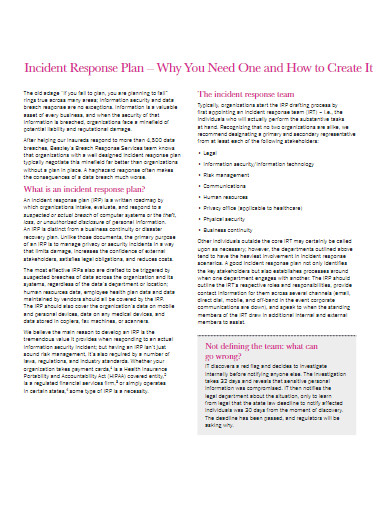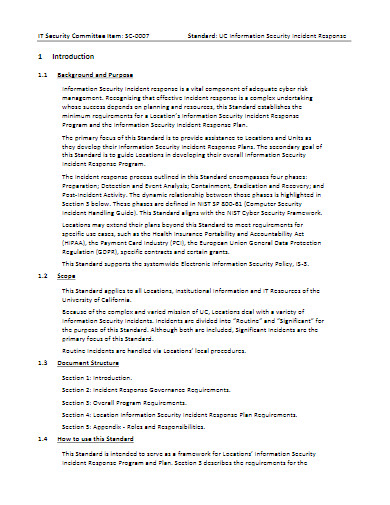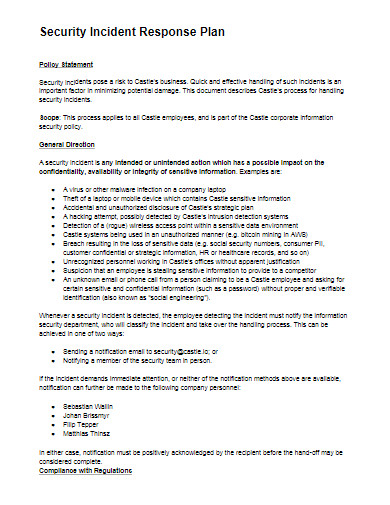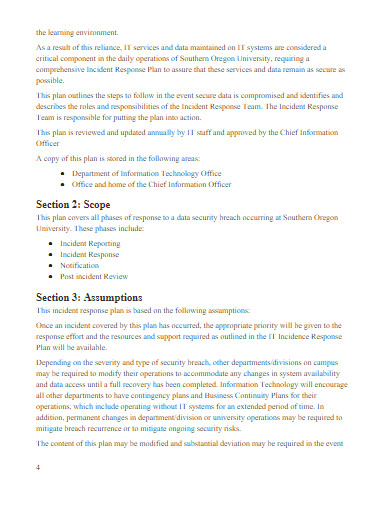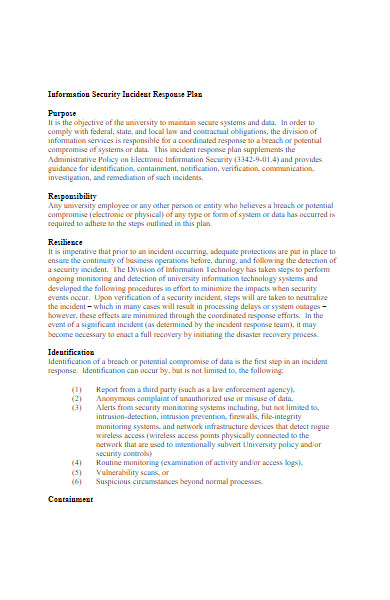10+ Incident Response Plan Examples to Download
All of us can’t predict when unwanted incidents would happen, especially in businesses. History has accounts on some companies that these events have taken by surprise, causing them to lose most of their operational assets. Because of those records, many organizations today organize processes to mitigate the damages the incidents could bring. These include incident management plans, risk management plans, business continuity plans, and other strategic projects to control emergencies. One good example of an undesired circumstance is a malware attack or data breach in a software company’s network security. The identification of even the weakest of malware is an indication for the development of the aforementioned plans and their corresponding cycles or workflows. Below, we introduce you to the incident response plans, which is another type of business scheme that involves preparation for incidents.
10+ Incident Response Plan Examples
1. IT Incident Response Plan Template
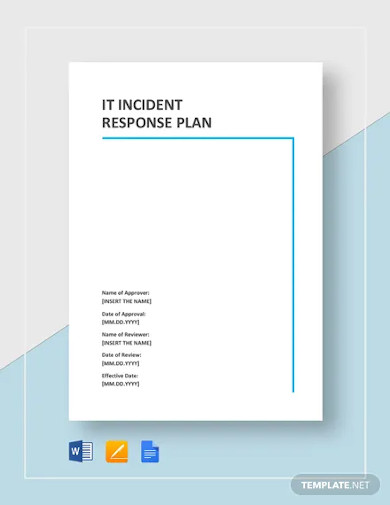
2. Cyber Security Incident Response Plan
3. University Incident Response Plan
4. Sample Incident Response Plan
5. Cybersecurity Incident Response Plan in PDF
6. Incident Response Plan Template
7. Information Security Incident Response Plan
8. Confidential Incident Response Plan
9. Simple Security Incident Response Plan
10. IT Incident Response Plan Template in PDF
11. Information Security Incident Response Plan Example
What Is an Incident Response Plan?
An incident response plan is a process document that entails fact-based actions and strategies. These elements help prevent unplanned events, lessen the negative impact on the business, and cap the damages they will be causing to the organization’s reputation, as well as financial and operational matters. IT companies and software developers commonly use this type of process document to handle issues like cybercrime, service outage, and loss of data. According to Cisco, the incident recovery team formulates such a plan. They are a group of people that gather, conserve, and analyze pieces of information relevant to incidents.
Types of Major Incidents
Major incidents refer to the predicaments that require the focused attention of an emergency service or two. They consist of six types, including natural causes, hostile acts, technological, civil unrest, health-related, and human error.
Natural Causes – incidents brought about by natural elements, such as earthquakes, tornadoes, and others
Hostile Acts – physical attacks done by civilians, terrorists, paramilitary, and military
Technological – incidents that are caused by a technological tool or equipment
Civil Unrest – disturbances provoked by an individual or group, like protests
Health-Related – incidents due to illnesses and diseases
Human Error – incidents that are unintentionally caused by an individual or group because of the lack of focus, knowledge, and other factors
How to Organize an Incident Response Plan
Incidents are inevitable, and their occurrences are unpredictable. Sooner or later, organizations may be experiencing them, which is why companies must organize an incident response plan in advance. To help you with that, we provide you with an outline that does not only make your document complete but also help you better understand the importance of each step.
1. Prepare the Necessary Details
When organizing an incident response plan, you start by preparing all the necessary details. These details have to be composed of the type of incident, the place and date it happened, as well as the people and equipment directly affected. You can gather the other particulars through various incident-related assessments.
2. Form a Team
After preparing the much-needed details, form a team that will be responsible for planning, implementing, and monitoring your incident response. In doing so, you have to make sure that its members possess relevant skills and are knowledgeable enough about the undertaking. One convenient way for you to know who to select is by conducting an employee analysis.
3. Identify Requirements and Schedules
Once you have successfully formed a team, identify the requirements needed to make your plan project valid. Some of the essentials are memos, authorization letters, notices, proposals, and others. Distribution of assignments to the response team member will also fall under this section with the accompaniment of work schedules.
4. Specify Strategies
With the requirements and schedules all set, you can proceed in specifying your response strategies. These strategies are usually referred to as incident response framework. Even though many frameworks have been established, the National Institute of Standards and Technology (NIST) and SysAdmin, Audit, Network, and Security (SANS) processes are most preferred.
5. Conduct a Test-Run
Following the specifying of strategies or incident response framework, you have to implement your incident response agenda initially. This step is beneficial to determine the faults within the program. This part of the process is most crucial in the risk management analysis of IT companies.
6. Debrief the Team
After accomplishing the steps mentioned beforehand, call out a meeting for a short debriefing. During this activity, findings have to be discussed with the whole team. Along with that, recommendations on how to mitigate or eliminate errors have to be presented. At the same time, suggestions on how to capitalize on opportunities need to be taken into account.
FAQs:
What are the incident response steps, according to NIST?
In NIST specifications, the steps in conducting an incident response include preparation, detection and analysis, containment, eradication, and recovery, and post-incident activity.
What are the incident response steps, according to SANS?
Unlike NIST, SANS’s framework expounds the steps more. They consist of preparation, identification, containment, eradication, recovery, and lessons learned.
What are the reasons why a company has to produce an incident response plan?
There are three main reasons why a business entity has to make an incident response plan. First, it helps protect data, which is important in both professional and personal aspects of an individual’s life. Second, it protects the businesses’ reputations and market trust. Lastly, through the protection in both reputation and market trust, the company will have an increase in revenue coming in its way.
Incidents come in different forms, right from the most natural to the advanced technological appearance. It is during their occurrences that the businesses are put to the test, leaving them with only two options—recover or fall. For corporate entities who prefer the former, an incident response plan is the most effective way to achieve so. Through such a process document, incidents will have less impact on the organizations’ operations to the business as a whole. To conclude this article, we’ll be leaving you with wise words from a renowned American government and nonprofit executive, Sylvia Matthews Burwell. The saying goes, “While natural disasters capture headlines and national attention short-term, the work of recovery and rebuilding is long-term.”



